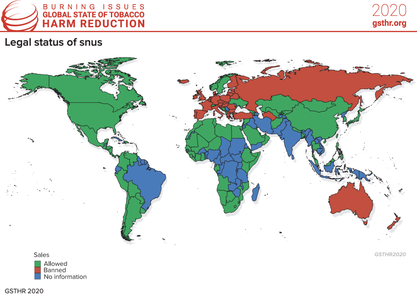Legal Status of Snus
Knowledge•Action•Change (2020)- Burning Issues: The Global State of Tobacco Harm Reduction 2020
Passed in 2001, the Tobacco Products Directive (TPD) was the first major European legislation specifically related to tobacco products. It is the only example of a regional approach to regulation. All EU member states must implement TPD into national Legislation.
Nearly a decade before, the first attack on what turned out to be a significant SNP was the EU-wide ban on the sale of snus in 1992, as a response to the attempt by the US Smokeless Tobacco Company to introduce oral Skoal Bandits into the UK. When Sweden joined the EU in 1995, snus was already in widespread use there and so was exempted from the ban.
In the years subsequent to TPD enactment, EU Commission reports identified new tobacco-related products which might be controlled to ensure conformity with EU harmonisation policies, noting increasing discrepancies between member states. As the sale of vaping devices was growing throughout the EU, member states were seeking advice and clarification from the Commission. In 2012, the Health and Consumer Directorate produced a proposal for the revision of the 2001 TPD whereby products with a nicotine content over a certain level – including most vaping products on the market – would have to be authorised as medicines. When the proposal came before the EU Parliament in 2013, numerous amendments to the Article were proposed, including one that all vaping products could only be sold as medicines under pharmaceutical regulations. Major objections from vapers via their EU political representatives helped derail this idea. In 2016, a revised TPD known as TPD2 came into force.
TPD2 regulates tobacco product manufacture, sale, distribution and advertising in the European Union covering vaping and HTP – with limitations on nicotine content and liquid bottle size – while reaffirming the ban on snus. Currently TPD2 is under review, with the report and possible proposals due out in May 2021.
See also p.119 of the report: Burning Issues: The Global State of Tobacco Harm Reduction 2020

